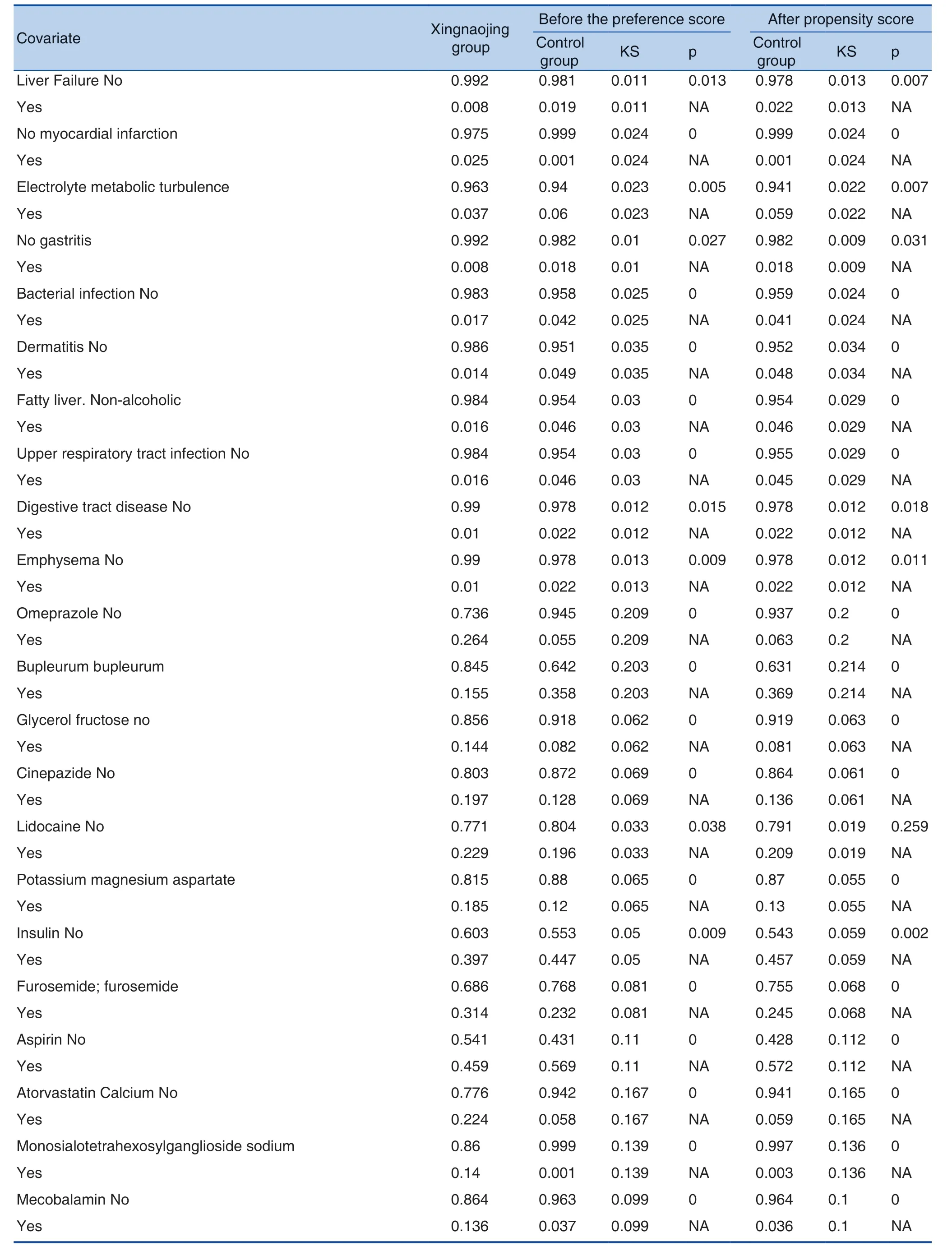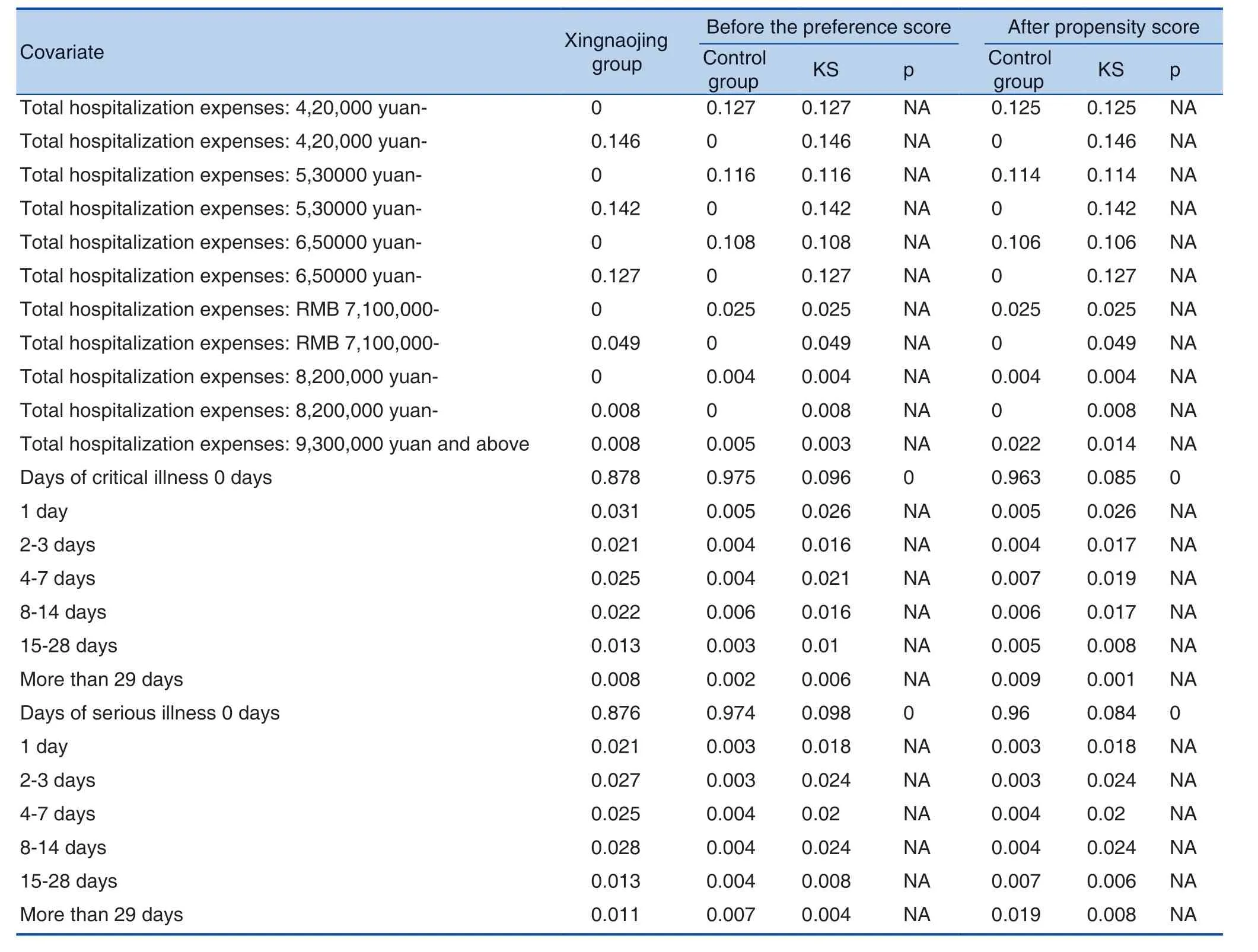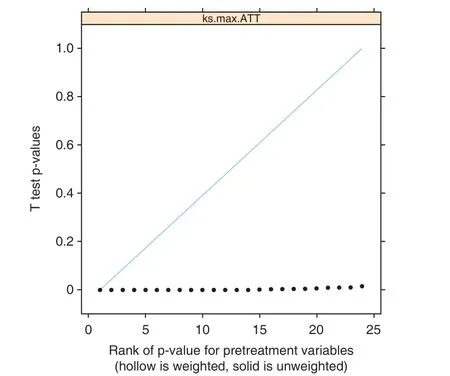Clinical Study on the Treatment Efficacy of Cerebral Hemorrhage with Xingnaojing Injection in Real World
2020-03-18ZHANGChengXIEYanming谢雁鸣WANGZhifei王志飞GAOYangWANGHanZHUANGYan
ZHANG Cheng (张 成), XIE Yan-ming (谢雁鸣), WANG Zhi-fei (王志飞),GAO Yang (高 阳), WANG Han (王 涵), ZHUANG Yan (庄 严)
1. Institute of Basic Research in Clinical Medicine, China Academy of Chinese Medical Sciences, Beijing 100700, China;
2. School of Statistics, Renmin University of China, Beijing 100872, China;
3. Naval General Hospital of Chinese People's Liberation Army, Beijing 100048, China
ABSTRACT Objective:The purpose of this study was to understand the clinical efficacy of Xingnaojing Injection in the treatment of cerebral hemorrhage in the real world.Methods:The hospitalized patients with cerebral hemorrhage mainly diagnosed in the hospital information system (HIS) of 22 3A hospitals in the country were selected as the research subjects. The patients with cerebral hemorrhage using Xingnaojing Injection were used as the Xingnaojing group. The group was matched with the same sex, age±5 years old,similar hospital admission conditions, matched according to 1:1 ratio. The patients with cerebral hemorrhage without using Xingnaojing Injection were used as the control group, and the therapeutic effects after treatment were used as outcome evaluation index. A total of 3 Logistic regression methods were used to analyze the effects of Xingnaojing Injection in the treatment outcome of patients with cerebral hemorrhage.Results:The statistical results showed that there was a difference in the efficacy of the treatment of cerebral hemorrhage by the use of Xingnaojing Injection (P<0.05).Conclusion:Based on the existing analytical methods and data, the effects of Xingnaojing Injection on cerebral hemorrhage are better than that of the non-use control group, which provides reference for the clinical drug use of cerebral hemorrhage.
KEYWORDS Xingnaojing; Cerebral Hemorrhage; Clinical Effects; Efficacy Study
Xingnaojing Injection (referred to as"Xingnaojing") is a new type of water-soluble intravenous Injection extracted from the famous traditional Chinese medicine fomula Angong Niuhuang Pill, which is extracted by modern technology[1]. Its main ingredients are Moschus(She Xiang), Borneolum Syntheticum (Bing Pian),Fructus Gardeniae (Zhi Zi) and Radix Curcumae(Yu Jin), etc., which have the effects of clearing heat and detoxifying, cooling and promoting blood circulation, and refreshing the brain. Clinically,it is widely used in the treatment of high fever,coma, cerebrovascular disease, craniocerebral trauma, encephalitis, acute poisoning and various vertigo[2].
Modern pharmacological studies have shown that[3-5]: Xingnaojing Injection can directly penetrate the blood-brain barrier and directly act on the central nervous system, which can effectively reduce the permeability of the blood-brain barrier, regulate the central nervous system, alleviate neuronal apoptosis, eliminate the antioxidant effects of oxygen free radicals, reduce brain edema and improve brain microcirculation etc. This study analyzed the hospitalization information of patients with Xingnaojing Injection in the HIS database of 22 large-scale 3A hospitals in China, aiming to analyze the clinical efficacy of Xingnaojing Injection on cerebral hemorrhage patients in real-world,providing new ideas and new methods for clinical efficacy evaluation after marketing.
DATA AND METHODS
Data Sources
The HIS data warehouse constructed by the Institute of Basic Research in Clinical Medicine, China Academy of Chinese Medical Sciences reviewed and analyzed the main diagnosis of cerebral hemorrhage in the information management system (HIS) of 22 3A hospitals in China from 1998 to 2016. The patients with cerebral hemorrhage using Xingnaojing Injection in the database were set as the Xingnaojing group,and the patients with cerebral hemorrhage without the use of Xingnaojing Injection were used as the control group, and the therapeutic effects after treatment were the outcome evaluation index.
Grouping Situation
Xingnaojing group
From the database, the main diagnosis information of patients with cerebral hemorrhage was selected, totaling 5642 cases, including the use of 267 patients with Xingnaojing data in the Xingnaojing group; And the case group according to age±5 years old same gender, the admission situation, 1:1 matching was performed.
Control group
The data of 267 patients with cerebral hemorrhage who did not use Xingnaojing were included in the control group. The specific data inclusion process is shown in Figure 1.
Data Standardization
As the research data comes from a number of hospitals, and the diagnostic criteria used by each hospital is different. In order to facilitate the analysis,the data in each hospital information management system must be regulated and standardized. The treatment outcomes in the original HIS data were reencoded: cure, and improvement coding was valid,and other, invalid, death code was invalid. The recoded treatment outcome was used as the outcome variable for comparison between the 2 groups to facilitate statistical analysis.
Statistical Methods and Statistical Software

Figure 1. Data into Flow Chart
Twang package was used in the R statistical software, the following 3 methods was used to estimate the processing effects: Method 1 Logistic regression of unbalanced confounding factors; Method 2 biased score-weighted Logistic regression; Method 3 For the propensity scoreweighted Logistic regression, accuracy of the results increased in turn. The statistical software is SAS software version 9.3, R software version 2.15.
RESULTS
Measurement and Sequencing of Confounding Factors
Different confounding factors have different relative influences in the process of calculating propensity scores. When estimating propensity scores,according to the contribution of each covariate to the model log likelihood improvement, the importance of their distribution in processing allocation is measured.The order results are shown in Table 1:
Propensity Score Weighted Analysis Results
The GBM (generalized boosted models)propensity score, PS) method was used to balance the confounding factors affecting the efficacy of the 2 groups. The results are shown in Table 2, Figure 2,and Figure 3:
Logistic Regression Analysis Results
As shown in Table 3. Method 1 univariate logistic regression was used. No confounding factors were considered. The results showed that the regression coefficient of 2.3123 was greater than 0, and the p value was less than 0.001, indicating that the treatmentresults of the Xingnaojing group was better than the control group. Method 2 After weighting the individuals of the control group with the propensity score, the univariate logistic regression was performed again to balance most of the confounding factors, and the results showed regression coefficients.

Table 1. Table of the Impact Degree of Confounding Factors on Processing Allocation, the Top 20
2.3123 was still greater than 0, and the p value was less than 0.001, indicating that the treatment results of the Xingnaojing group were better than the control group. Method 3 The confounding factors was included in the still existing in the logistic regression model. The regression coefficient calculation and test found that the coefficient was 3.956561 less than 0, and the P value was less than 0.001, indicating that the treatment results of the Xingnaojing group were better than the control group.In summary, the degree of treatment of confounding factors was increased by 3 logistic regression analysis methods. The results showed that the effects of Xingnaojing group on cerebral hemorrhage was better than that of the control group.
DISCUSSION
The Effectiveness and Mechanism of Xingnaojing in the Treatment of Cerebral Hemorrhage
Cerebral hemorrhage is the second largesttype of stroke, with high mortality and disability.The pathogenesis is related to hypertension and amyloid cerebrovascular disease. The pathological mechanism is cerebral edema formation,hematoma enlargement, perihematomal damage,thrombin release and inflammatory response[7].Early mortality is high, and most of the survivors have different degrees of dyskinesia, cognitive impairment, speech dysphagia and other sequelae etc. Clinical studies have shown[6], for patients with acute cerebral hemorrhage, treatment with the addition of Xingnaojing can significantly reduce the mortality rate, improve the neurological deficit in a short period of time, promote the recovery of consciousness of patients with cerebral hemorrhage,reduce body temperature, eliminate brain Edema and so on.

Table 2. Balance of Propensity Score Weighted Before and After Covariates

(Continued)

(Continued)

(Continued)

Figure 2. Changes in the Effects Amount Between the 2 Groups Before and After the Propensity Score Weighting

Figure 3. The Balance of k-s Test Covariates Before and After Propensity Score Weighting in 2 Groups

Table 3. Analysis of 3 Methods for the Treatment of Cerebral Hemorrhage
I n t h e p h a r m a c o l o g i c a l m e c h a n i s m,Xingnaojing Injection can reduce the serum NSE and hs-CRP levels in patients with acute cerebral hemorrhage, thereby reducing brain damage caused by inflammatory reaction after cerebral hemorrhage and protecting nerve cells[8]. MA Zheng et al[9]also confirmed that the combination of Xingnaojing Injection on the basis of conventional treatment can significantly reduce serum IL-6,hs-CRP, TNF-α levels, and further alleviate the inflammatory response in the body. In addition,cerebral edema secondary to cerebral hemorrhage is the main cause of secondary space-occupying brain injury, and has a great impact on the prognosis of the disease.
Plasma NPY concentration is a sensitive marker of brain injury, and Xingnaojing Injection can reduce the cerebral edema volume of patients with cerebral hemorrhage by reducing the level of NPY in venous blood of patients, which may be one of the mechanisms of Xingnaojing in the treatment of cerebral hemorrhage[10]. This study used Logistic regression analysis, and the results obtained confirmed the effectiveness of Xingnaojing Injection in the treatment of cerebral hemorrhage in the real world, which was consistent with clinical reports.
Real World Research and Propensity Score Weighting
Real world research is increasingly becoming a focus of attention in the field of medical research,which is especially widely used in recent years in traditional Chinese medicine industry, and can provide evidence that traditional randomized controlled trials cannot provide, including the efficacy of interventions in real-world environments and the evidence of safety, compliance, and disease burden etc., which is an important supplement to traditional clinical research models[11]. But because there is no randomized controlled design, the baseline and prognosis differences between groups always exist more or less and may cause bias in results.
In order to reduce bias, it is necessary to use appropriate statistical analysis methods to balance the confounding factors. The commonly used statistical analysis method is propensity score weighting method to balance the distribution of observed variables in the treatment group and the control group, thereby reducing bias and increasing the comparability of the 2 groups. The use of propensity scores allows observational clinical studies to achieve post-hoc randomization without over-stratification and over-matching, thus bringing the results closer to the real-world interventions[12].
In this study, combined with clinical practice,there are many confounding factors in the Xingnaojing group and the control group, which may be related to the treatment results. If the combined underlying diseases are different, the therapeutic effects may be different. The significant results obtained by chi-square test may not truly reflect the difference in therapeutic efficacy between Xingnaojing and the control group, which may be exaggerated or reduced due to differences in the distribution of certain confounding variables in the 2 groups. Therefore, we need to control the effects of confounding factors by some methods.
From the reality of HIS data in this study, the main confounding factors are: combined disease,combined medication, patient occupation, patient sick days, patient critical days, hospitalization days(segmentation), total hospitalization expenses,hospitalization expenses category etc.
By establishing a log-likelihood ratio of abnormal changes in the index, whether the grouping variable uses the Logistic regression model of the brainstorming were determined. The regression coefficient value of the grouping variable is the value of the efficacy outcome. When the sample size is sufficient, by weighting the propensity score and using GBM method to continuously optimize.
KS statistic and minimize it, so that the confounding factors between the Xingnaojing group and the control group are well balanced. The unbalanced confounding factors were analyzed as covariates in the Logistic regression model, and the accuracy was improved in turn. The results of the 3 Logistic regression analyzed showed that the Xingnaojing group was better than the control group in treating cerebral hemorrhage.
Limitations of the Study
As this study is a retrospective data observation and analysis, the efficacy outcome evaluation in the HIS database comes from the doctor's subjective judgment on the patient's discharge diagnosis, which cannot accurately reflect the patient's clinical reality.In the real world clinical practice, there are still many unknowns potential bias and confounding factors,which may affect the outcome of the curative effects,and in turn affects the accuracy of the results. In realworld research, these unknown confounders cannot be addressed by using existing statistical methods.Therefore, the results of this study only provide reference for clinicians to treat cerebral hemorrhage.In order to obtain more accurate conclusions, further prospective clinical trials are needed.
SUMMARY
The effects of Xingnaojing Injection on cerebral hemorrhage is obvious, and the safety reports of clnics are rarely reported. The retrospective analysis also shows that there is a difference between the clinical use of Xingnaojing in the treatment of cerebral hemorrhage and the unused efficacy outcome, which provides scientific reference for clinical doctors. But because this study is a retrospective data analysis study, it has certain limitations, so the demonstration of its effectiveness needs to be confirmed by prospective clinical trials.
猜你喜欢
杂志排行
World Journal of Integrated Traditional and Western Medicine的其它文章
- INSTRUCTION FOR AUTHORS
- Some Novel Viewpoints on Physiology and Pathology of TCM Sphygmology
- Thinking on the Treatment of Lung Cancer by Regulating Lung-Intestinal Axis Microecology by Traditional Chinese Medicine
- The West Learns from China, Creating Chinese New Medicine-Academician of Western Medicine TANG Zhao-you's View on the Integration of Traditional Chinese and Western Medicine
- New Year's Message
- Exploration on Integrative Traditional Chinese and Western Medicine Strategy for Treating Patients of Lung Cancer over 80 Years Old
